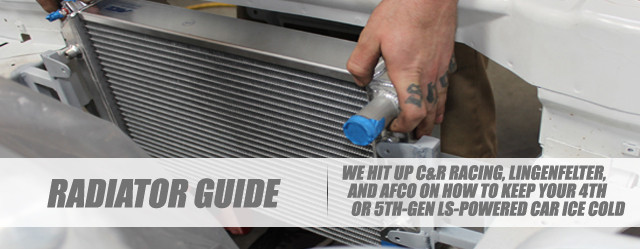One of the most neglected upgrades during an engine build is the cooling system; specifically, the radiator and its supporting components. Factory cooling components, like the radiator, were designed to cool a factory engine’s horsepower output. When the output of that engine is increased the amount of heat that is generated follows.
The radiator is just one of many components of the cooling system that will need to be upgraded. We reached out to some heavy hitters in the industry such as C&R Racing, Lingenfelter Performance, and AFCO to gain some insight on cooling a 4th or 5th-gen LS-powered car.
Every component in a factory cooling system plays a vital role to keeping coolant flowing at operating temperature. Depending on the use of the car and the weather conditions, the temperature can increase at an alarming rate, possibly causing it to overheat. Our goal for this guide is to contribute sources for cooling system components for 4th and 5th-gen LS-powered cars.
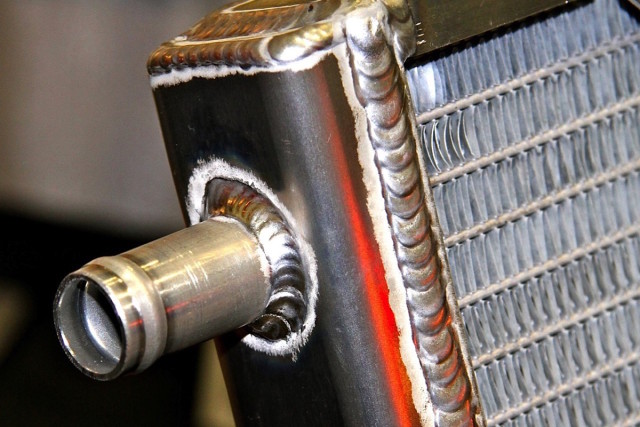
C&R Racing also offers LS swap radiators for many applications, including classic musclecars like this ’69 Camaro.
Radiators And More With C&R Racing
Most modern OEM radiators are built as single-core units which are made partially out of plastic. These units do a satisfactory job of cooling a factory LS engine. However, many companies recommend upgrading to a single or even a dual-core aluminum crossflow or downflow radiator that is specific to its application. Aluminum as a material has a 25 to 25 percent more efficient cooling capacity than an OEM plastic-core unit.
It’s not uncommon that enthusiasts upgrade to larger wheels and tires. That places a demand on your steering components, so it’s recommended to upgrade the power-steering cooler. – Paul Hammond, C&R Racing
“For 5th generation LS-powered cars like the Camaro, we have a direct-fit performance-core radiator for the ’10 to ’12 Camaro SS equipped with a LS3 from the factory. That radiator fits in the stock location, allowing it to bolt-in just like a factory unit. With the performance-core design, you have the ability to retain some factory radiator features as well. It’s a 600 horsepower capable radiator, which is our most popular radiator option.”
C&R Racing 2010-2012 Camaro SS Dual-Core Aluminum OE-Fit Radiator
- Downflow style radiator
- Dual 56 mm core aluminum construction
- Complete as a kit including transmission cooler
- Transmission cooler uses factory GM quick disconnect fittings
- OE fit into factory location
- Uses factory electric fan, A/C condenser, and seals
- Overall height is 21.375 inches
- Overall width is 30.5 inches
- 600 horsepower capacity
- PN 20-00020
“There are several solutions available for engine oil coolers, including our own. Additionally, a power steering cooler should be considered. It’s very possible to boil the power steering fluid during a track day or at an autocross event. It’s not uncommon that enthusiasts upgrade to larger wheels and tires. That places a demand on your steering components, so it’s recommended to upgrade the power-steering cooler. The power-steering cooler can be mounted into your radiator, which is what we recommend. We use our own coolers on our NASCAR and roadrace applications.”
C&R Racing’s inline power steering cooler (PN 41-50000) features an all aluminum constructed unit, which utilizes 1 1/4-inch outlets for OE-like fitment. The inline power steering cooler can also be mounted inside of the radiator.
Hammond also touched on the importance of a good radiator cap, saying, “Upgrading to a pressurized radiator cap would be ideal. The factory cap is only around 13 to 15 pounds. A 21-pound radiator cap will allow the cooling system to increase the boiling point of the fluid. A higher pressure cap in the range of 20 to 30 pounds is more optimal. Especially during track days.”
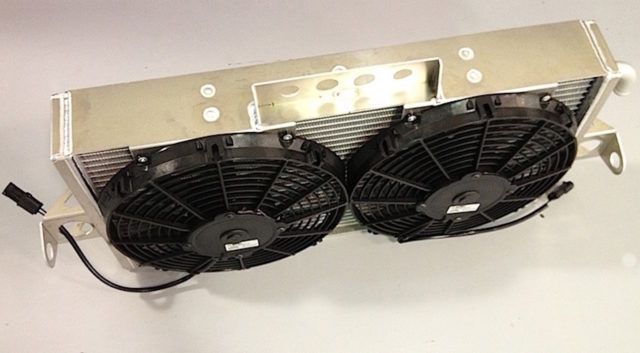
Lingenfelter offers a high-capacity intercooler heat-exchanger package for the 5th-gen Camaro SS and ZL1 model. PN L320061410
Keeping Track Of Temperatures With Lingenfelter
Lingenfelter offers a variety of cooling system components, such as radiators, water pumps, and thermostats. From 4th gen F-body cars and 5th gen Camaros, to late model Pontiacs, Corvettes, and the CTS-V.
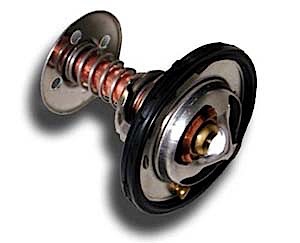 We spoke with Mike Copeland, engineer for Lingenfelter Performance. We’ve interviewed Copeland in the past when he shared Lingenfelter’s C7 Corvette with us. Copeland says, “Depending on the application, the cooling system components that will need to be upgraded will vary. If power levels are in the 500 range or lower, we would recommend upgrading from an OEM thermostat to a lower temperature thermostat. Above the 600 horsepower range, enthusiasts should highly consider an aftermarket radiator. Additional components such as cooling fans and the water pump often need to be upgraded at this level of power as well. Lingenfelter’s 160-degree thermostat (PN L310045297) is compatible with a variety of GM vehicles, and is a direct drop-in replacement for the factory thermostat. The unit does not need any modifications, and includes a new rubber seal gasket. From GM’s 4.8-liter V8 all the way up to the 6.0-liter V8, this thermostat will be compatible.”
We spoke with Mike Copeland, engineer for Lingenfelter Performance. We’ve interviewed Copeland in the past when he shared Lingenfelter’s C7 Corvette with us. Copeland says, “Depending on the application, the cooling system components that will need to be upgraded will vary. If power levels are in the 500 range or lower, we would recommend upgrading from an OEM thermostat to a lower temperature thermostat. Above the 600 horsepower range, enthusiasts should highly consider an aftermarket radiator. Additional components such as cooling fans and the water pump often need to be upgraded at this level of power as well. Lingenfelter’s 160-degree thermostat (PN L310045297) is compatible with a variety of GM vehicles, and is a direct drop-in replacement for the factory thermostat. The unit does not need any modifications, and includes a new rubber seal gasket. From GM’s 4.8-liter V8 all the way up to the 6.0-liter V8, this thermostat will be compatible.”
Lingenfelter Heavy Duty Aluminum Radiator For '93-'02 4th Gen F-Body From Be Cool
- 100 percent Aluminum construction
- Dual 1-inch tube core
- Single-pass design
- Form-folded straight tank
- Compatible with all types of coolant
- Direct-fit mounting with OEM sized inlet/outlet locations
- Billet filler neck includes high-capacity overflow tube
- Automatic transmission version includes heavy-duty transmission cooler
- 100 percent pressure tested
- PN BC62028/BC60028
Copeland also explains the importance of a functional thermostat as well. The thermostat not only plays the role of displaying the engine temperature, but it also allows the car to run at a cooler temperature. He says, “The factory thermostat is set to engage the fans at 195 degrees. We offer a 160-degree and 180-degree thermostat choice, which are made specifically for 4th and 5th-gen LS engines. They’re an easy-to-install component and are direct replacements for the OEM unit with no modifications necessary for fitment.” The company also includes all of the necessary seals with its thermostat package.
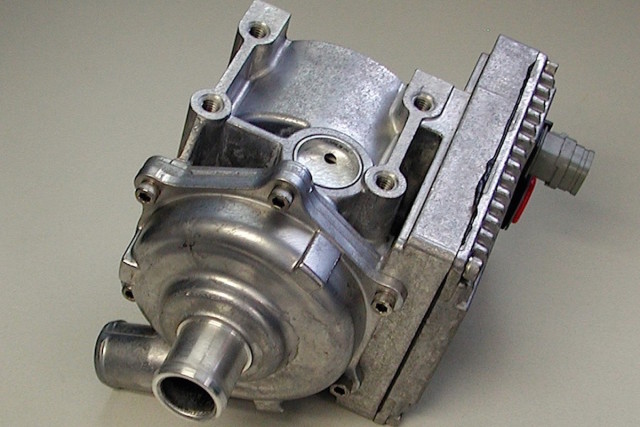
Lingenfelter a offers high-volume electric intercooler pump (PN ST-1030002107) which pumps up to 25 pounds of coolant per hour at only 12-amps of power. The pump utilizes one-inch diameter openings and features 60 percent more flow than a factory ZL1 pump, and is compatible with the ’10 to ’14 5th-gen Camaro, and all 4th-gen F-body cars.
Lingenfelter's high-capacity radiator is comprised of aluminum, and is a dual-core construction. The package is compatible with '10 to '14 Camaro SS and ZL1 models which utilize either a turbocharged or supercharged application. The wiring harness included provides the provisions for using a manual relay override controller. This is a time delayed device that allows for the circulation of coolant into the intercooler, which allows the fans to run after shutting the vehicle off. This ultimately reduces heat soak between runs.
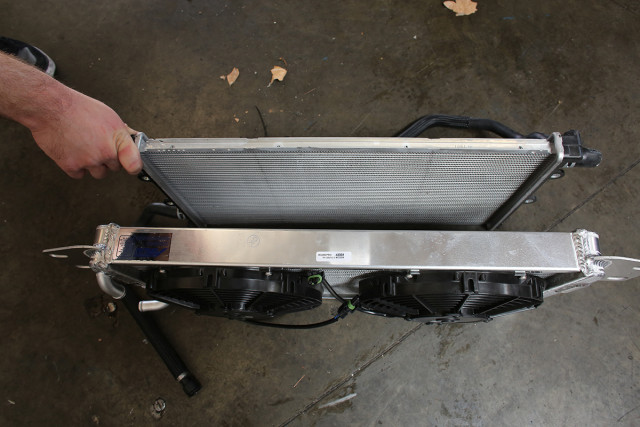
Check out the sheer size difference between an OEM 5th-gen ZL1 Camaro radiator and an AFCO heat exchanger module.
Evaluating With AFCO Racing
Jay Miller is the cooling products manager at AFCO Racing. Because Miller has an extensive knowledge surrounding the 4th and 5th-gen LS engines, we asked him when enthusiasts should consider upgrading the cooling system components.
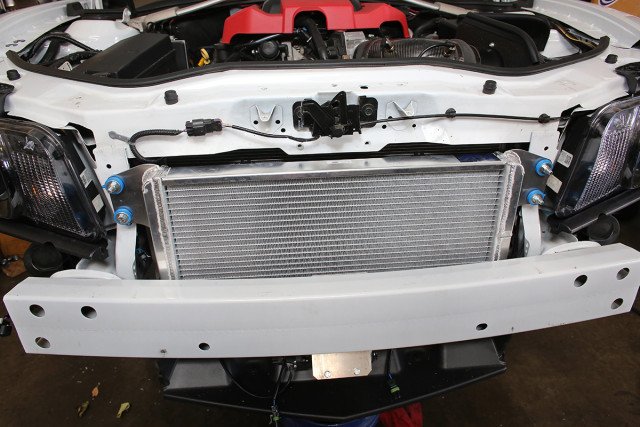 “It’s recommend to upgrade the cooling system once horsepower levels have superseded 450 crank horsepower. Our recommendation would be a dual-core aluminum radiator. It’s also a good idea to evaluate the water pump to ensure it can handle the new radiator’s coolant capacity,” Miller said. He recommends it because as the 4th-gen LS-powered cars came from the factory using low-capacity plastic-tank radiators which had minimal core surface, and are not ideal for a performance-oriented forced induction set-up. AFCO offers solutions for virtually every application available; from drag racing, circle track, road racing, and more. The company offers hundreds of direct-fit radiator solutions for many 5th-gen LS-powered applications, as well as LS swapped applications. These units utilize the factory mounting location, making the swap as easy as installing a factory unit.
“It’s recommend to upgrade the cooling system once horsepower levels have superseded 450 crank horsepower. Our recommendation would be a dual-core aluminum radiator. It’s also a good idea to evaluate the water pump to ensure it can handle the new radiator’s coolant capacity,” Miller said. He recommends it because as the 4th-gen LS-powered cars came from the factory using low-capacity plastic-tank radiators which had minimal core surface, and are not ideal for a performance-oriented forced induction set-up. AFCO offers solutions for virtually every application available; from drag racing, circle track, road racing, and more. The company offers hundreds of direct-fit radiator solutions for many 5th-gen LS-powered applications, as well as LS swapped applications. These units utilize the factory mounting location, making the swap as easy as installing a factory unit.
AFCO 5th Gen Camaro Aluminum Black Downflow Radiator With Transcoder
- Dual row one-inch core aluminum construction
- Direct-fit in factory location
- Accepts factory fan shroud
- Condenser mounts to new radiator
- In-tank transmission cooler mounts directly inside radiator for all automatic and manual Camaros
- Custom black anodized finish
- Engineered and manufactured in-house
- Furnace-brazed sealed core using no epoxy
- 100 percent tested before shipping
- PN 80259B
Because the F-body world has become a more diverse platform over the years, we prompted Miller about the custom and universal radiators AFCO offers enthusiasts for virtually every F-body application imaginable. Many F-body enthusiasts have dual purpose cars, such as a daily-driven street car which sees strip time on the weekends. In the case of our 4th generation F-body Camaro, we utilized an AFCO double-pass aluminum radiator based on our intended purpose of daily driving and drag racing. Regarding our 5th-gen ZL1 Camaro, we took advantage of an AFCO heat exchanger in order to keep our intake-air-temperature as low as possible, while providing a safe-haven for the entire engine through the included fan module combination. The company also understands the need for a high-performance replacement for every LS application cooling solution, which is why it also offers direct-fit LS swap radiators for early GM vehicles.
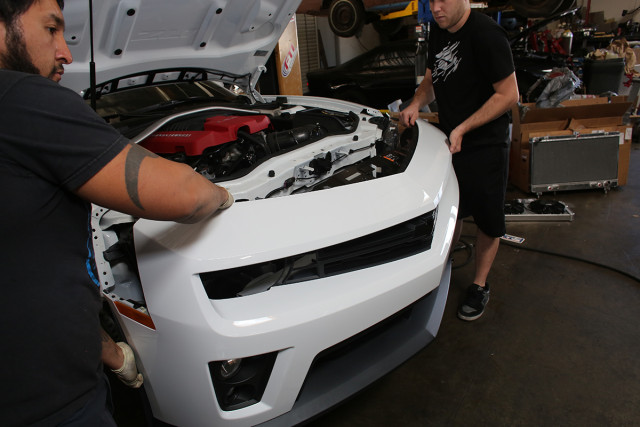
Check out the full details on our AFCO heat exchanger install for our 5th-gen ZL1 Camaro here.
Conclusion
We’ve learned that factory components and their performance will begin to decline when forced induction or high horsepower levels are introduced into the mix. Not all radiator modules are engineered for the same purpose or application.
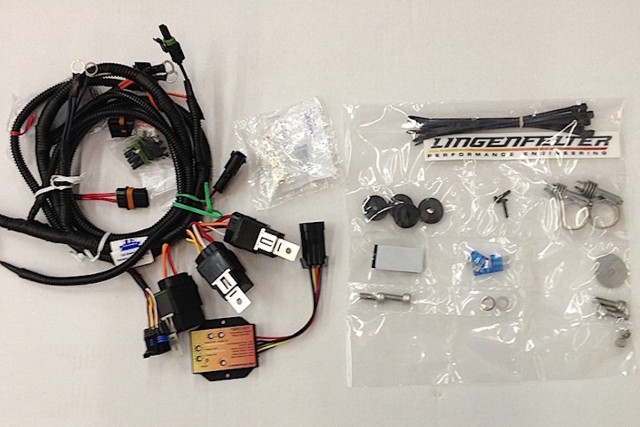 As we mentioned previously, it’s a common misconception that upgrading from a factory radiator to a high-performance unit will be enough when enthusiasts choose a forced induction route. However, after speaking with these three manufacturers it’s quite clear that the cooling system needs to be evaluated as a whole as power increases. When considering the cooling system in its entirety, it’s often the case that components such as the water pump and thermostat should undoubtedly be upgraded at the same time.
As we mentioned previously, it’s a common misconception that upgrading from a factory radiator to a high-performance unit will be enough when enthusiasts choose a forced induction route. However, after speaking with these three manufacturers it’s quite clear that the cooling system needs to be evaluated as a whole as power increases. When considering the cooling system in its entirety, it’s often the case that components such as the water pump and thermostat should undoubtedly be upgraded at the same time.
The intake air temperature needs a way to stay cool, which means keeping heat from robbing the engine of horsepower. – Mike Copeland, Lingenfelter Performance
Whether you’re in the market for a new radiator or an entire cooling system overhaul the experts at any of the companies we consulted for this article can help enthusiasts get the products they need for the performance they desire.



